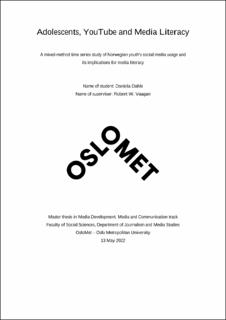| dc.description.abstract | One of the side effects of the Corona pandemic amongst Norwegian youth was increased screen time and social media usage. As a result, the need to sharpen critical senses became increasingly significant. This master thesis explores whether the social media usage of adolescents has impacted their media literacy in any way during and in the immediate aftermath of the pandemic.
Established theories within the field of media and communication are applied to answer the research questions, mainly uses and gratifications theory and cultivation theory. Moreover, theories on media literacy, social media, YouTube, and marketing are also integrated. A mixed-method approach was most appropriate for answering the research questions. Method triangulation thus consisted of content analysis, focus group interviews and surveys. In combination with all primary methods, cultivation analysis was central as well.
Amongst significant findings from the analysis are the following. Youth are not familiar with what media literacy or similar terms mean and seem to associate them solely with technical aspects. Nearly all news consumption continues to take place on social media. There was a lack of mention of media ownership and implications for users. Fact-checking techniques on YouTube now seem to not only involve looking at sources but also 'view counts' and 'likes', which are distressing means of establishing credibility. Similar to earlier findings, young people's media literacy skills regarding advertising seem to be stronger than other aspects.
Based on the analysis of all findings from 2018 to 2022, the overall impression is that increased social media usage during the pandemic has had some, albeit minimal, impact on adolescents' media literacy. However, scepticism has evolved and is more activated, although not always accompanied by concrete actions. The momentum of the aftermath of the pandemic should be utilised to increase digital literacy knowledge and skills amongst Norwegian adolescents. | en_US |
